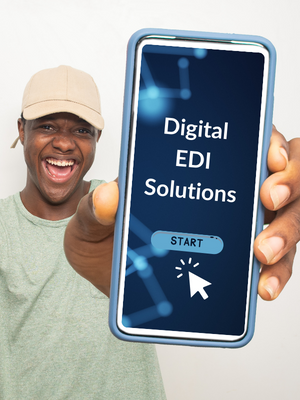
A group of fourteen people with different ethnic backgrounds sitting around a round, white table with different color social networking related icons on its surface. There is a gray and white floor beneath them.
Do you work in or manage an inclusive team? Do you feel that you can bring your whole self to work and be accepted – even valued – for your individual insights? Do you feel encouraged to share your views, insights and experiences at meetings? Are you inspired by your leader and colleagues and encouraged to contribute beyond the job description?
If you answered yes to the above questions, congratulations! It appears you’re working in an inclusive environment which is making the most of your individual talents and values. Sadly, most of us probably don’t.
So what? You say. Why is it so important to create a culture that’s inclusive?
The benefits of an inclusive corporate culture
Let’s begin by defining the concept. In my experience, an inclusive corporate culture is an environment that allows each individual to be him or herself, one that not only sees our individuality as our strength but also knows how to leverage it for a more successful and effective team.
It is the kind of environment that encourages every person to offer their freshest and diverse thinking.
Why is this important? Because, in today’s fast-paced world, in order for companies to remain competitive, they need to harness the collective brainpower of all their people, not just of a small group of top managers. To do that, leaders must create an environment that respects and values a wide variety of thinking styles, experiences and approaches.
Simply put, in order for a business to successfully leverage the full capacity of its people, it must operate an inclusive culture that encourages and values diverse thinking and contribution.
How do we create an inclusive culture?
There are many ways in which to create a culture that respects and values different opinions, styles of thinking and expression. Here are three of mine:
- Capture the Creativity of Each Team Member
Stephen Covey famously said “Strength lies in differences, not in similarities.” This makes sense. After all, what can we learn from someone who has the same views, upbringing and experiences as we do? It may feel more comfortable to have a colleague confirm our decisions, but it doesn’t make that decision better. Well-considered decisions are those that have been scrutinised from many perspectives. Understanding what repercussions our decisions might have requires enquiry from every angle.
Start by inviting each person’s freshest thinking in meetings. One of the ways to do so is to understand in advance what contribution you want from the team and set the agenda for the meeting with this in mind. What is it that you want the team to accomplish? Is it to come up with a new strategy? To discuss the pipeline? To consider the financial results of the team to-date? Whatever the aim, when setting the agenda, a team leader should ensure it is clear from the agenda what that objective is.
Also, set the agenda in the form of questions. Framing each agenda item as a question will instantly engage the brain of each participant and signal the message that, not only are they requested to attend but they are also expected to discuss the questions at the meeting.
Inviting each team member to participate as a thinker and contributor will help overcome the customary meetings in which 70% of the talking is done by 30% of the participants, and help set the tone for inclusive meetings and culture.
- Learn to Listen
Ben Simonton, the author of Leading People to be Highly Motivated and Committed said: “Listening is absolutely critical to creating a work environment in which employees will decide on their own to become highly motivated, committed, fully-engaged, and in that kind of condition they’re going to literally love to come to work.”
Listening is about becoming a thinking partner. A good listener conveys trust and commitment, and shows others that they care about them. It’s only when we properly listen to individuals that we can tap into what’s driving them and their behaviours. It’s also when we start noticing things about them that aren’t obvious, like their preferences, fears, external motivators. Listening enables us to tap into what’s going on beneath the surface and bring out insights that we generally cannot expect to hear or see.
Although it sounds simple, genuine (active) listening takes practice. Most of us aren’t great listeners – or at least didn’t start out that way. The good news is that active listening is as much a skill as learning a language, a song or a dance routine. The more you practice it, the better you get at it – and it’s an absolutely vital skill for any good leader.
- Switch on your Unconscious Bias Radar
Let’s face it: we are all guilty of unconscious bias! You knew that, right? And while there is an enormous amount of Unconscious Bias training going on, the first thing we need to understand and accept is that it is perfectly natural and is in fact our brain’s way of protecting us.
Unconscious bias is the brain’s way to group similar facts and experiences and arrive at quick judgments without having to analyse afresh each factual scenario. It is, in fact, part of learning. For example: if, as a child, you are bitten by a dog, chances are you will be avoiding dogs at all costs because your brain will surmise that all dogs bite and remember that you didn’t like that experience. That’s unconscious bias at work.
Of course, most people who may have had a bad dog experience as children grow out of being afraid of them and in fact learn to love them. So the good news is that we are able to teach our brain to discern between those dogs that may bite and those that won’t. In other words, we have taught our brain to challenge our unconscious bias and, as a result, have reaped the benefits of having a loving and loyal pet and friend.
But how do we make that transition from being afraid of dogs who bite to loving them?
This is where the Unconscious Bias Radar comes in handy. In the example above, it was probably a friend or a parent who helped us switch on our Unconscious Bias Radar. And we learned to challenge our brain’s rash judgment that all dogs will bite.
When it comes to unconscious bias at work, however, it isn’t quite as simple. Most of the time, we are unaware of our biases; we don’t tend to know when we judge others unconsciously. So we must make a conscious effort to switch on our Unconscious Bias Radar and challenge our judgments in those situations when they are not welcome.
So next time you’re discounting someone because they’re dressed differently, ask yourself, does that matter? And if so, how?
Next time you assume that a woman with young children will not be interested in taking up a secondment overseas, ask yourself, am I judging her by my own standards or is there any objective evidence that helped me come to that conclusion?
Next time you meet a man who prefers to spend time with his family rather then hold a lofty corporate title, and you think something is wrong with that, ask yourself, what precisely is wrong with that?
Challenging our own judgment is the first step to overcoming unhelpful unconscious bias. Switching on our Unconscious Bias Radar will ensure that we utilise our brains’ filters in the most effective way and reap the benefits of our diversity.
Want to learn more about how to create inclusive cultures? Give me a call and see how we can support you.
And don’t forget to come to our Inclusion Conference: Ordinary People, Extraordinary Contributions on 21 June 2017. Featuring speakers who are walking the walk, you will meet role models, be inspired by those who have found strength to share their hidden talents and learn how to encourage and nurture extraordinary contributions from colleagues and team members. Meet the law firm partner who founded Inspiring Women – a mentoring charity with 20,000 female mentors. Meet the athlete who, having reached the top of her own ambition, is now helping other retired athletes to integrate into ordinary life. Meet the man who calls himself a feminist and who –as a senior management consultant partner – is using his influence to help professional women get ahead. You will also meet some extraordinary charities – run by ordinary people – who are changing the world, one person at a time. Join our speakers, charities and delegates, all of whom are creating and nurturing inclusive corporate cultures.


